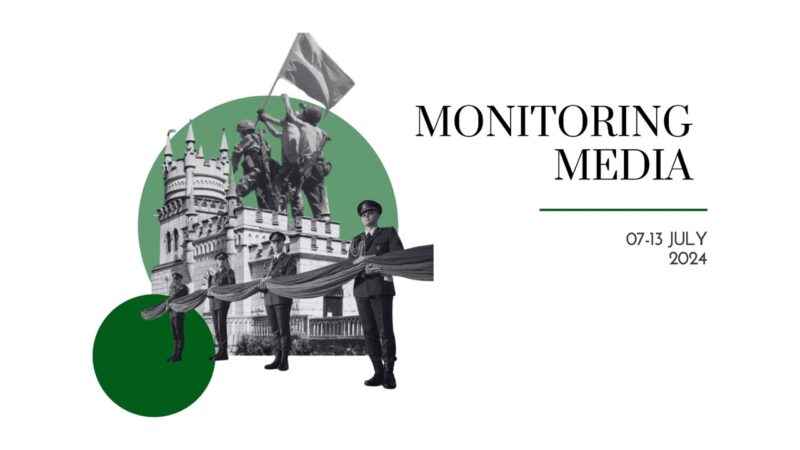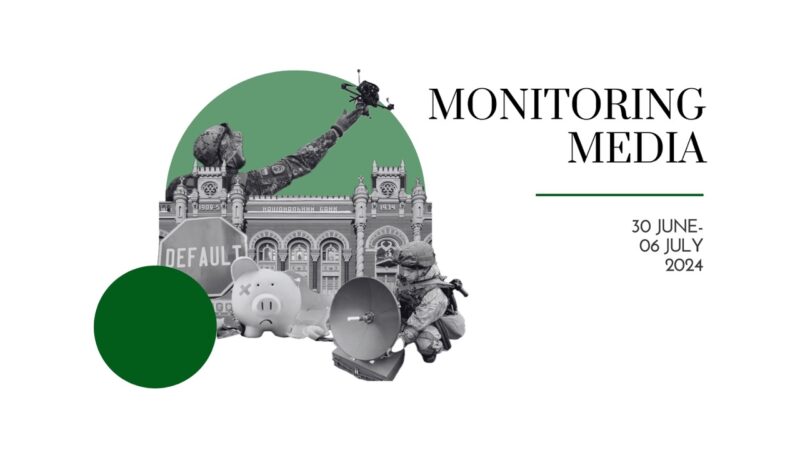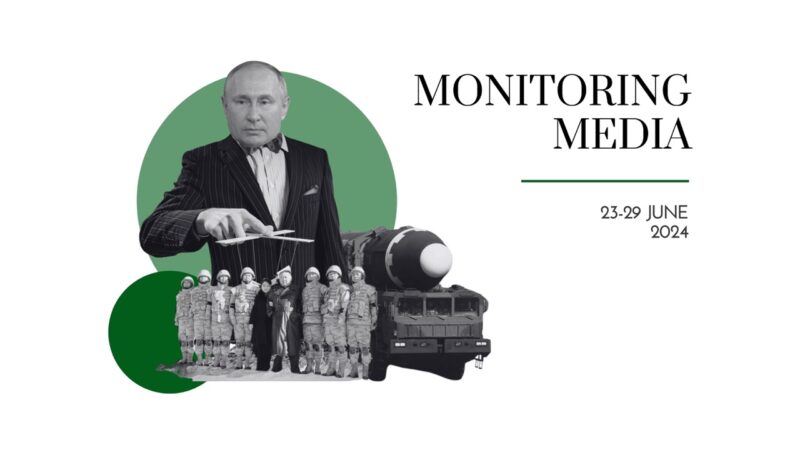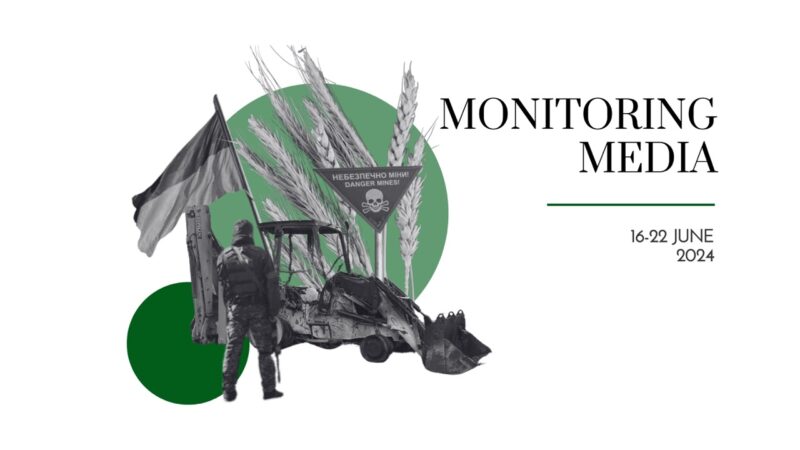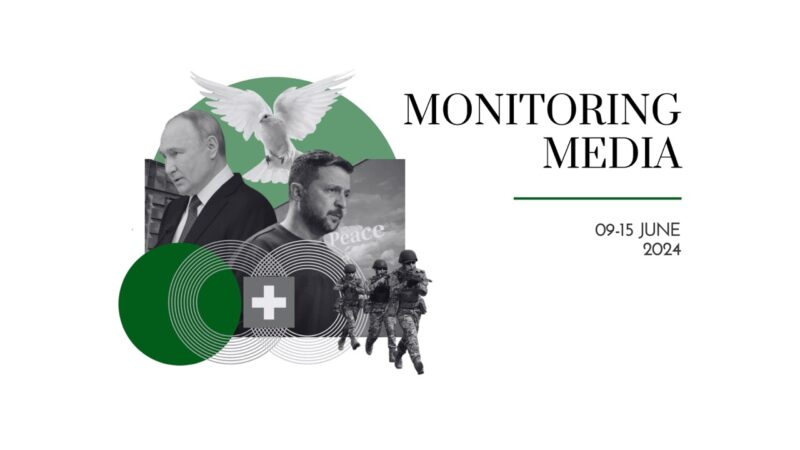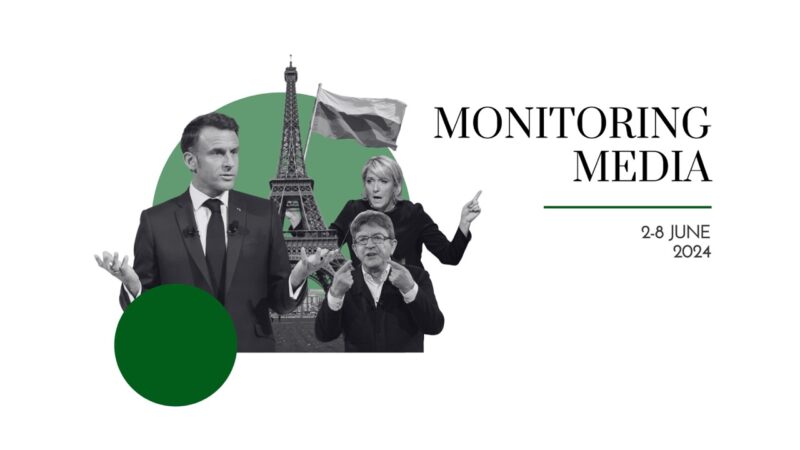International legal mechanisms being put in place to prosecute Russian criminals
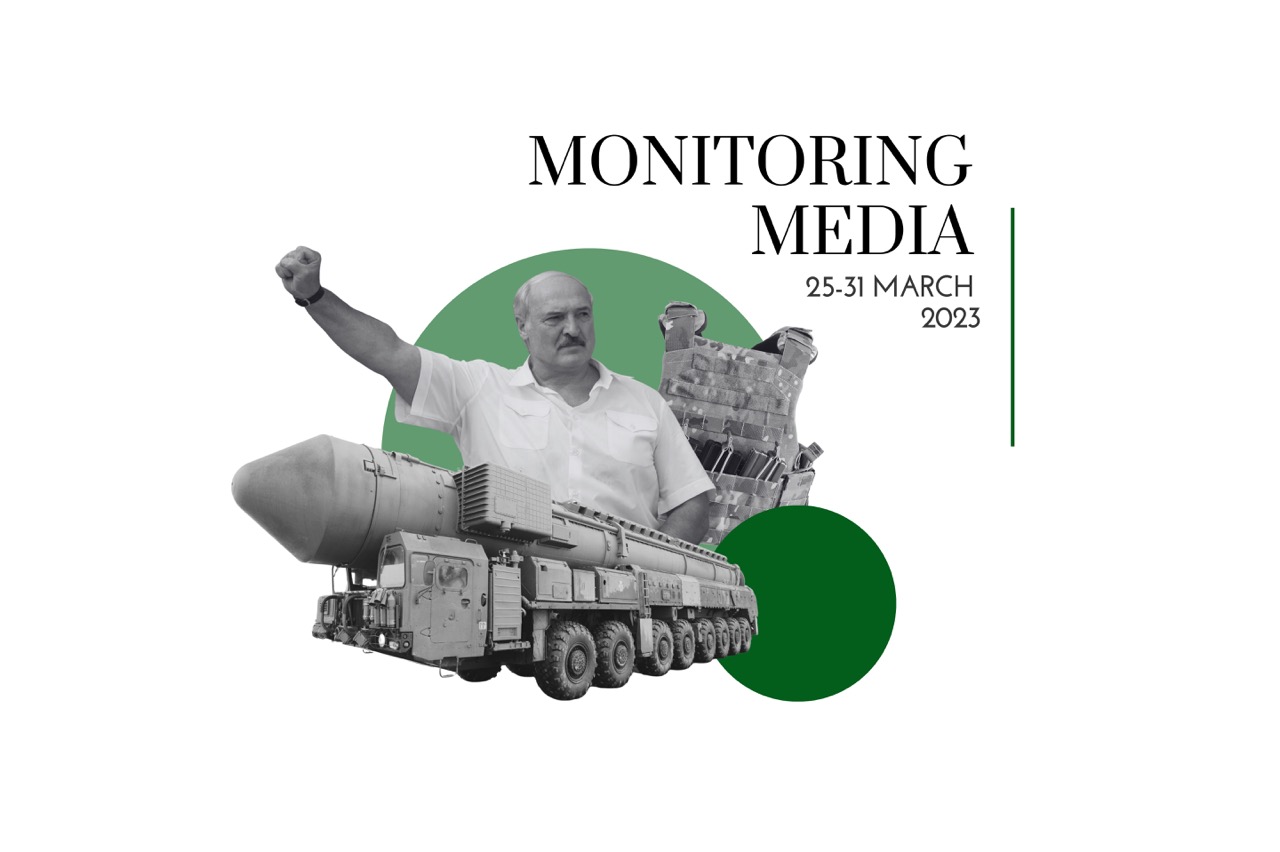
CIUS weekly report on North American media coverage of Ukrainian affairs, 25–31 March 2023
Three publications (The Wall Street Journal, The New York Times, and Politico) were selected to prepare this report on how the situation in Ukraine has been portrayed in the North American press during the past week (25–31 March 2023). The sample was compiled based on their impact on public opinion as well as on their professional reputation, popularity among the readership, and topical relevance. These three publications represent centrist and conservative viewpoints on the political spectrum.
This report covers only the most-read and relevant articles about Ukraine, as ranked by the respective North American publications themselves in the past week. Its scope covers promoted articles on home pages and articles from special sections on Ukraine, with the hashtag #Ukraine, from the paper editions of the publications, and about Ukraine from opinion columns and editorials.
Topics featured in the selected articles:
- Ukraine’s current affairs: Ukraine continues to successfully defend Bakhmut; success of Ukraine’s spring counteroffensive will depend on the effective utilization of limited resources;
- The world and Ukraine: Washington and Kyiv develop legal mechanisms to bring high-ranking Russian criminals to justice; US national interest resides in supporting Ukraine till its victory; the West remains undecided on how much and for how long it should support Ukraine;
- Russia at war: failure to conquer Bakhmut will become an astonishing defeat to Russian army; Russia imports ammunition and weapon components from China; Russian threats to deploy nuclear weapons in Belarus should not be given credence.
Main arguments:
Ukrainians proved to be capable of defending Bakhmut. Isabel Coles and Evan Gershkovich (Wall Street Journal) cite General Valery Zaluzhny, Commander-in-Chief of Ukraine’s Armed Forces, who states that the front lines around the eastern city of Bakhmut are stabilizing after months of gruelling combat. This update is corroborated by messages from Western analysts that the Russian winter offensive is losing its momentum and wearing off. At the same time, Bakhmut continues to be in the centre of the fighting and remains the most challenging spot along the front line. The Russian command has been sending human waves to overwhelm Ukraine’s defenders there for months but has failed to sever their supply lines and has suffered heavy casualties. “By holding on to the city, Ukraine has sought to prevent Russia from making progress toward its goal of seizing the rest of the eastern Donetsk region, while weakening its capacity to mount further offensives.” At the same time, many Western analysts are still arguing that Ukraine’s uncompromising defence of Bakhmut was a mistake because it depleted “Ukrainian combat power ahead of an anticipated offensive using fresh, Western-trained troops and modern equipment provided by the US and its allies.” In turn, leaders of the Russian mercenary group Wagner complain that their soldiers lack the ammunition to continue fighting and risk encirclement in Bakhmut. The promise by Putin to triple in ammunition production is yet to materialize (if it ever happens, considering the impact of sanctions). This is one of the reasons that has prompted Russia to shift its operational focus toward other battle theatres—for instance, Avdiivka in the south.
Ukraine’s improvisation, coordination, and exploitation of Russia’s weak points are the keys to success in the spring counteroffensive. Daniel Michaels and Ian Lovett (Wall Street Journal) discuss Ukraine’s preparations for the spring counteroffensive and assess its chances for success: “It will need a combination of skill and luck, finding and quickly exploiting weak points.” On the one hand, Ukraine possesses Western weaponry and training, and its soldiers are highly motivated. On the other hand, Russian forces have had time to entrench themselves in the occupied territories, and their brutality and sheer numbers should never be underestimated. Because Ukraine cannot afford to mount a massive aerial attack—which is crucial at the early stages of an offensive against a deeply entrenched enemy—“Kyiv’s prospects will depend on its ability to coordinate different types of troops, including artillery units, tank corps, and foot soldiers, in what are known as combined-arms maneuvers.” Effective targeting of Russia’s logistics bases, command centres, and supply lines, especially in the Russian rear, will continue to remain a key element in ensuring Ukraine’s success. For this to happen, long-range high-precision ammunition is of decisive importance—yet the West delivers it selectively and/or in modest numbers. Furthermore, advancement of the infantry may be hampered by comparatively few main battle tanks and armoured vehicles on the Ukrainian side; that being said, there is no exact information on how many Soviet-designed units Ukraine lost on the battlefield or how many were captured from the Russian side. It also remains unclear which part of frontline Ukraine the counteroffensive will commence in. Common sense tells that Ukraine will not risk breaking through the most fortified areas but rather will probe the weakest points on the front line. However, “physical defenses are only an obstacle if well defended … If Russian troops don’t man trenches, Ukraine can bulldoze them and advance.” A presumed objective of the counteroffensive is to sever the land corridor that Russia has established in Ukraine’s southeast.
Ukraine and its Western allies work on bringing high-ranked Russian war criminals to justice. Glenn Thrush and Charlie Savage (New York Times) discuss the creation of a specialized international mechanism to investigate crimes of aggression committed by Russia’s leaders in Ukraine, though they do mention that President Putin may be shielded from prosecution. Thrush and Savage highlight that there exist two designs to restore justice, as put forward by Kyiv and Washington. The first envisages establishing a hybrid court rooted in the Ukrainian judiciary system, with international elements. Such a design will capitalize on the already existing base of recorded crimes in Ukraine and allow for comparatively quick proceedings—but it also may lack funding and raise complications for making Putin accountable, as current Ukrainian legislation prohibits the prosecution of sitting heads of state. The second design envisages creating a brand-new tribunal that will specifically address Russia’s crimes in the ongoing war: “Several former diplomats and academics want the United Nations General Assembly to set up a purely international judicial institution like the International Criminal Court at The Hague, which prosecutes war crimes and has ruled that it need not honor immunity for sitting heads of state.” However, this design may take time to be implemented and achieve universal legitimacy. Although the ICC recently issued an arrest warrant accusing Putin of abducting Ukrainian children, it is not suited for prosecuting war crimes of the Russian leadership. This stems from Russia being a non-signatory to the Court’s treaty, which consequently makes it illegal for its citizens to be tried in Hague.
US national interest resides in supporting Ukraine till its victory. Former senior advisor to President George W. Bush (2000–2007) Karl Rove (Wall Street Journal) argues that “besides being moral, it’s in [the US] strategic and economic interest to help stop Putin.” He opens the article by criticizing the US neo-isolationists and leftists who either claim that the Russo-Ukrainian war is of no importance to their state or that it was instigated by the US promotion of democracy in Eastern Europe. Rove counters this by stating that “Mr. Putin could have lived in peace with a democratic Ukraine, just as Russia has coexisted for decades with neighboring democracies Finland and Norway.” However, with the acquiescence of his people Putin decided to “reconstruct Russia’s imperial empire.” In this light, the US’s support for Ukraine is a morally right deed that has already brought historical revenues: not only has the Kremlin become weaker and NATO grown stronger but unity has appeared among the Western democracies—an unseen phenomenon since the end of the Cold War. But if the US steps back today and Russia is allowed to win, then Washington will need to counter a domino effect of detrimental developments: authoritarian regimes will become more assertive across the globe; Russia will continue its advancement and threaten the NATO states in Central Europe (to which the US will be obliged to respond by deploying troops); the EU will get weaker and diminish its trade with the US—specifically, fossil fuels and electronics; the US’s Asian partners will lose their trust in the American security umbrella and become more open to cooperation with China; and finally, US military and defence enterprises will lose revenues as orders plummet. Rove concludes that “aiding Ukraine is putting America’s interests first.”
The West remains ambivalent about how to help Ukraine win and what will happen after the victory. Paul Beckett and Laurence Norman (Wall Street Journal) write that Ukraine’s Western allies see the endpoint of the war but have no feasible plan for how to achieve it. On the one hand, Ukraine’s forthcoming spring counteroffensive will likely change the balance of power on the battlefield; on the other hand, there remain too many undefined variables to predict what will come after Ukraine’s counteroffensive. This ambiguity stems from Western doubts that the counteroffensive will unfold neatly and bring long-lasting effects, as well as from the desire of allies to end the war fast and with minimum investment, unclarity on what to do with defeated Russia and Putin in particular, and the absence of compromise on what to do with Ukraine after it wins (i.e., to what extent should Ukraine be allowed to integrate into transatlantic structures). The authors believe that Putin is aware of these undefined variables and made a stake on the war of attrition: he wants to wait out Western resolve and then achieve his objectives, whether through renewed attacks or negotiations; “the prospect of a possible change in the U.S. administration in 2024 might also encourage Mr. Putin if he believes a Republican president would offer less support for Kyiv.” The strategy of waiting out the West worked fine for Putin following the invasion of Georgia (2008), the annexation of Crimea (2014), and the inflammation of Syria’s civil war (2015). For his part, President Zelensky is motivated to liberate all of Ukraine’s territories—though it may come at a great cost, as the events near Bakhmut demonstrate. Beckett and Norman argue that “Ukraine’s allies could do more to tilt the balance in Kyiv’s favor. But the provision of the kinds of weapons that might achieve that has been a source of disagreement.” The analysts conclude that the war in Ukraine is “a defining moment for democracies everywhere” and a last chance for the US to reassert its global leadership against authoritarian challengers.
Russia continues to throw human cannon fodder in the fight for Bakhmut, a city with little strategic value. German Lopez (New York Times) writes that, ignoring all the odds, Russia has been trying for months to capture Bakhmut city in the Donbas. The city has no strategic value for the invading army but may yet become a symbolic milestone: “Putin…is desperate for a win—any win…If Russia can take Bakhmut now, Putin can argue to the Russian people, to his allies in China and Iran, and to Western supporters of Ukraine that Russia is making gains and has momentum. A win could boost morale among Russian forces and hurt international support for Ukraine.” Lopez highlights that even if Russia succeeds in taking Bakhmut, this will come as a Pyrrhic victory considering the number of troops and equipment lost since August 2022, when the first massive offensives were mounted. Conversely, Russia’s failure to advance will come as an astonishing defeat: “If Russia can’t capture the city even with the investment of so many resources, how can it expect to win the broader war?” Ukraine’s stake is also risky, by sending an increased number of troops and equipment to defend the city. If not there, these resources might have been more effectively used in the forthcoming spring offensive. At the same time, wearing Russia down in Bakhmut may also help Ukraine to break through the weakened front line. Lopez concludes that “how the fighting in Bakhmut will be judged, then, depends on what happens next and how the consequences play out on the rest of the battlefield.”
Russia imports “dual-use items” and weapon components from China. Erin Banco and Steven Overly (Politico) write that a Russian body armour manufacturer imports Chinese components for its bulletproof vests: “In 2022, multiple Chinese companies, including one linked to the government in Beijing, sent parts for body armor manufacturing to Klass, a Russian manufacturer of body armor with ties to the country’s national guard and law enforcement.” After being assembled, the vests are used by Russian invading forces in Ukraine, for which Banco and Overly found photo and video evidence. This fact of Chinese-Russian trade raises the question of how the US plans to address the issue of Beijing’s “dual-use items” (i.e., commercial equipment that can also be used for military purposes, such as metal sheets for bulletproof vests and assault rifles or electronics for drones). Another issue is closing the loopholes in the system of international sanctions, which is predominantly focused on preventing Russia from acquiring ready-made weaponry, not its components. At the end of their article the authors cite a US expert on exports who claims that “it’s impossible for the US to completely cut Moscow off from many exports. Not only are some foreign-made products beyond the government’s reach, but the sale of illicit goods will always be lucrative enough to attract bad actors.”
Russia threatens to deploy nuclear weapons in Belarus in another round of nuclear blackmail. Erin Banco (Politico) states that US and EU officials and analysts doubt Putin’s intention to transfer tactical nuclear weapons to Belarus anytime soon; at least, there is no “indication—such as satellite imagery or other intelligence—that shows Russia is moving forward with an immediate plan to deploy [these weapons].” Instead, the US and EU officials and analysts believe that Putin’s most recent nuclear rhetoric is an attempt to rattle the Ukrainians and distract from the Kremlin’s losses on the battlefield. Banco cites John Bolton, a national security adviser during the Trump administration, who believes that even Russia moving some of its nuclear arsenal to Belarus will not change the balance of powers in the region: “The capabilities Russia already has in the Kaliningrad enclave [west of Belarus] are the ones that could be most threatening.”
